Coming Again to a Garden Near You: Basil Downy Mildew
go.ncsu.edu/readext?804616
en Español / em Português
El inglés es el idioma de control de esta página. En la medida en que haya algún conflicto entre la traducción al inglés y la traducción, el inglés prevalece.
Al hacer clic en el enlace de traducción se activa un servicio de traducción gratuito para convertir la página al español. Al igual que con cualquier traducción por Internet, la conversión no es sensible al contexto y puede que no traduzca el texto en su significado original. NC State Extension no garantiza la exactitud del texto traducido. Por favor, tenga en cuenta que algunas aplicaciones y/o servicios pueden no funcionar como se espera cuando se traducen.
Português
Inglês é o idioma de controle desta página. Na medida que haja algum conflito entre o texto original em Inglês e a tradução, o Inglês prevalece.
Ao clicar no link de tradução, um serviço gratuito de tradução será ativado para converter a página para o Português. Como em qualquer tradução pela internet, a conversão não é sensivel ao contexto e pode não ocorrer a tradução para o significado orginal. O serviço de Extensão da Carolina do Norte (NC State Extension) não garante a exatidão do texto traduzido. Por favor, observe que algumas funções ou serviços podem não funcionar como esperado após a tradução.
English
English is the controlling language of this page. To the extent there is any conflict between the English text and the translation, English controls.
Clicking on the translation link activates a free translation service to convert the page to Spanish. As with any Internet translation, the conversion is not context-sensitive and may not translate the text to its original meaning. NC State Extension does not guarantee the accuracy of the translated text. Please note that some applications and/or services may not function as expected when translated.
Collapse ▲Master Gardener℠ volunteers (MGVs) participated in a delicious pilot project during the summer of 2021 and are preparing to take it to the next level in 2022. By growing a whole lot of basil in their yards and faithfully collecting weekly data, MGVs helped monitor for a sneaky organism known as Basil Downy Mildew (BDM) which attacks mid-summer, turning basil leaves yellow then brown.
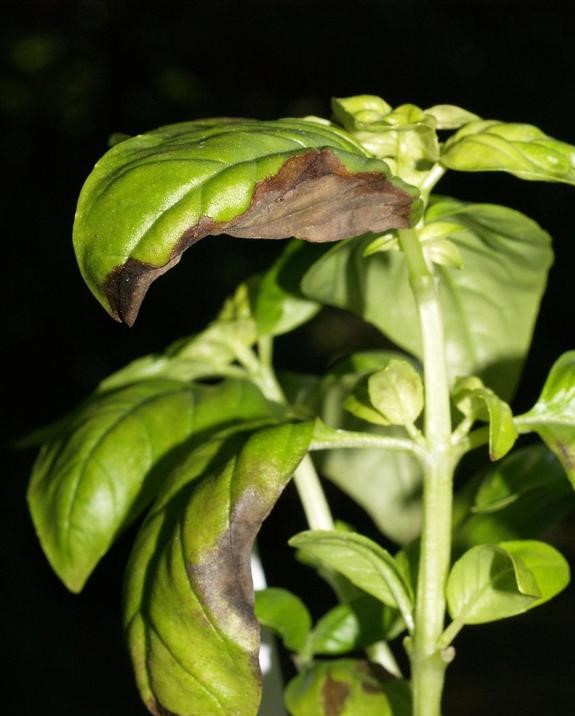
Leaves of basil turn yellow then brown when infected by basil downy mildew. Photo by Bruce Watt, University of Maine, Bugwood.org
BDM is caused by the oomycete Peronospora belbahrii, a fungal-like organism that reproduces via spores that travel on the breeze. It loves warm, humid temperatures (especially warm nights), and spreads when spores are picked up by the wind and land on nearby plants. BDM spores don’t like cold weather, and don’t survive through winter in states like North Carolina where temperatures drop below freezing. Instead, it spends the winter further south in frost-free areas or in greenhouses. When the weather warms, spores catch a ride on the wind and travel surprisingly long distances across state lines, usually arriving mid to late summer.
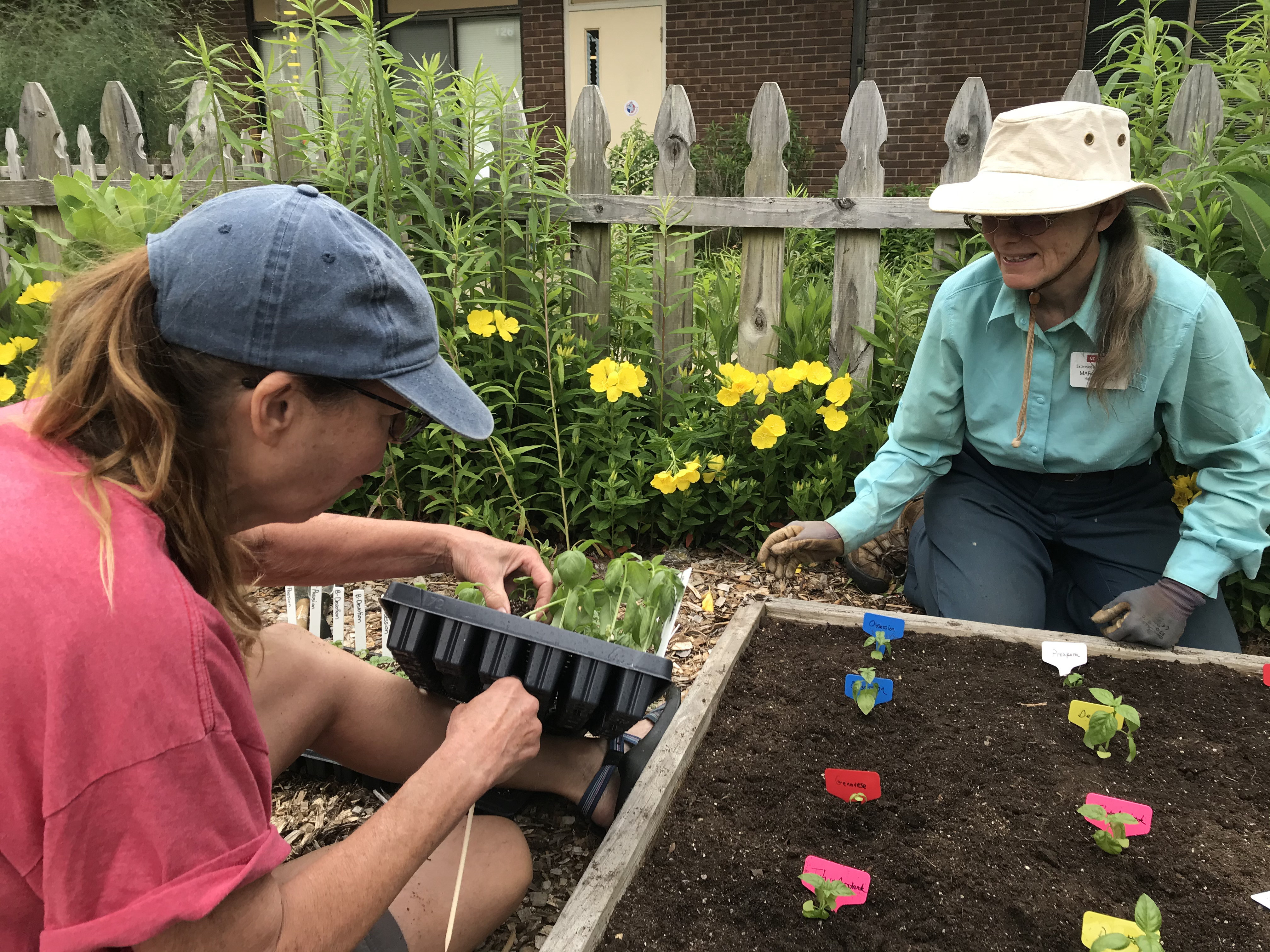
Dale Reece and Marcia Tate, EMGVs of Haywood County laid out the different basil varieties according to the experimental design. Photo by Sam Marshall.
How Will I Know When It’s Arrived?
Once a spore lands on a leaf and infects the plant, symptoms appear within 10 days. The first sign a gardener will notice is yellowing of the leaves, particularly in between the leaf veins. While yellowing, known as chlorosis, can be mistaken for a nutritional deficiency, a look at the underside of the leaves can help confirm BDM. The presence of lots of purple-brown spores on the underside of the leaves is a sure sign of infection. Eventually, the yellow parts of the leaves turn brown, ultimately leading to the death of the entire plant.
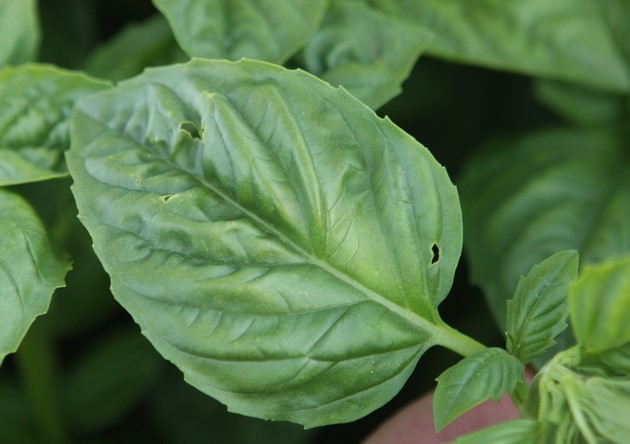
Leaves begin to yellow when infected by Basil Downy Mildew. Photo by Gerald Holmes, Strawberry Center, Cal Poly San Luis Obispo, Bugwood.org
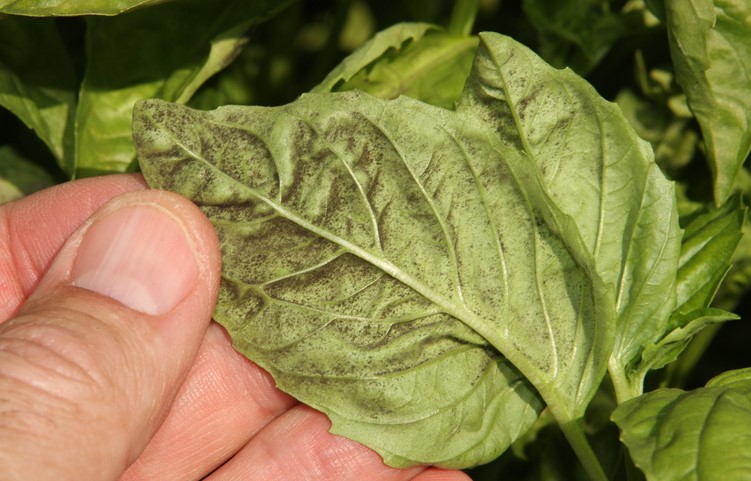
Spores of Basil Downy Mildew on the underside of basil leaves. Photo by Gerald Holmes, Strawberry Center, Cal Poly San Luis Obispo, Bugwood.org
There is no easy fix for BDM; fungal spray programs are labor-intensive, depend heavily on getting the timing just right, and there are no products available to home gardeners that are effective at controlling BDM. BDMs annual arrival in NC is reported on the AgPestMonitor (which offers the opportunity to sign up for alerts when BDM is reported in your county).
How Can I Ensure a Big Basil Crop?
The specific variety (or cultivar) of basil that backyard gardeners choose to grow can dramatically affect whether or not BDM will spoil their Caprese salad in a given year. The good news is that plant breeders have developed new, BDM-resistant varieties of basil. But even among these new varieties, some will be more resistant, more vigorous and most importantly, more delicious than others. And it’s important to remember that BDM infections vary in intensity depending on the weather. Some years, BDM is prolific in certain parts of the state; in other years or in other parts of NC, it is barely detectable.
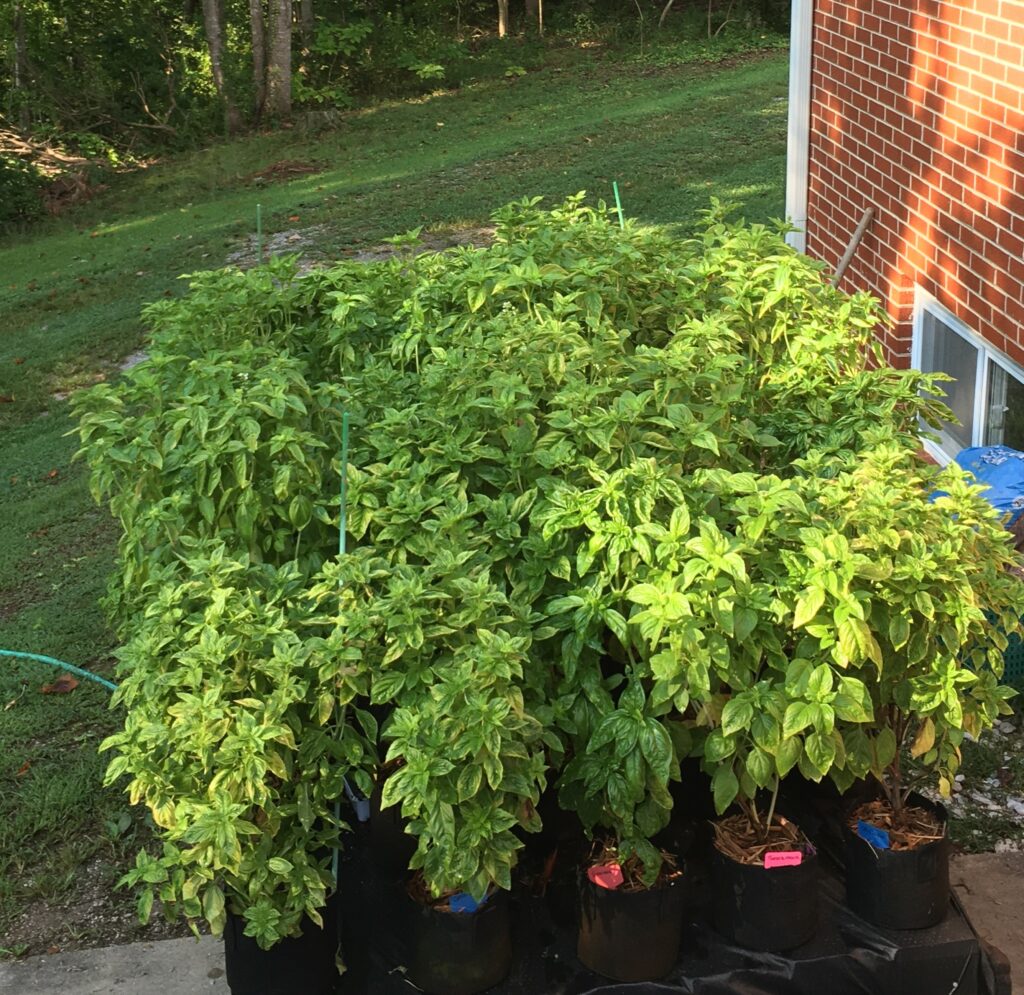
Summer 2021 basil plot in McDowell County. Photo by Carole Keller, EMGV of McDowell County.
How Are Master Gardener Volunteers Helping?
In the summer of 2021, 30 Master Gardener volunteers in four counties representing each growing region of NC (mountains, piedmont, coastal plain) participated in a pilot research project. MGVs set up test plots either in their own backyard or at the local County Extension Center. Five varieties of basil bred to be BDM-resistant were compared to the highly popular, yet susceptible ‘Genovese’ variety. Varieties in the trial included ‘Rutgers Obsession-DMR’, ‘Rutgers Devotion-DMR,’ ‘Rutgers Thunderstruck-DMR,’ ‘Rutgers Passion-DMR’ and ‘Prospera’. Each week throughout the summer, MGVs examined each plant and rated it from 0 to 3, based on a disease severity scale. Of course, resistance to BDM is a desirable trait, but most importantly gardeners and consumers want basil to taste good! To gauge the flavor of resistant varieties, volunteers conducted taste tests comparing BDM resistant varieites to ‘Genovese’ basil, the culinary favorite.
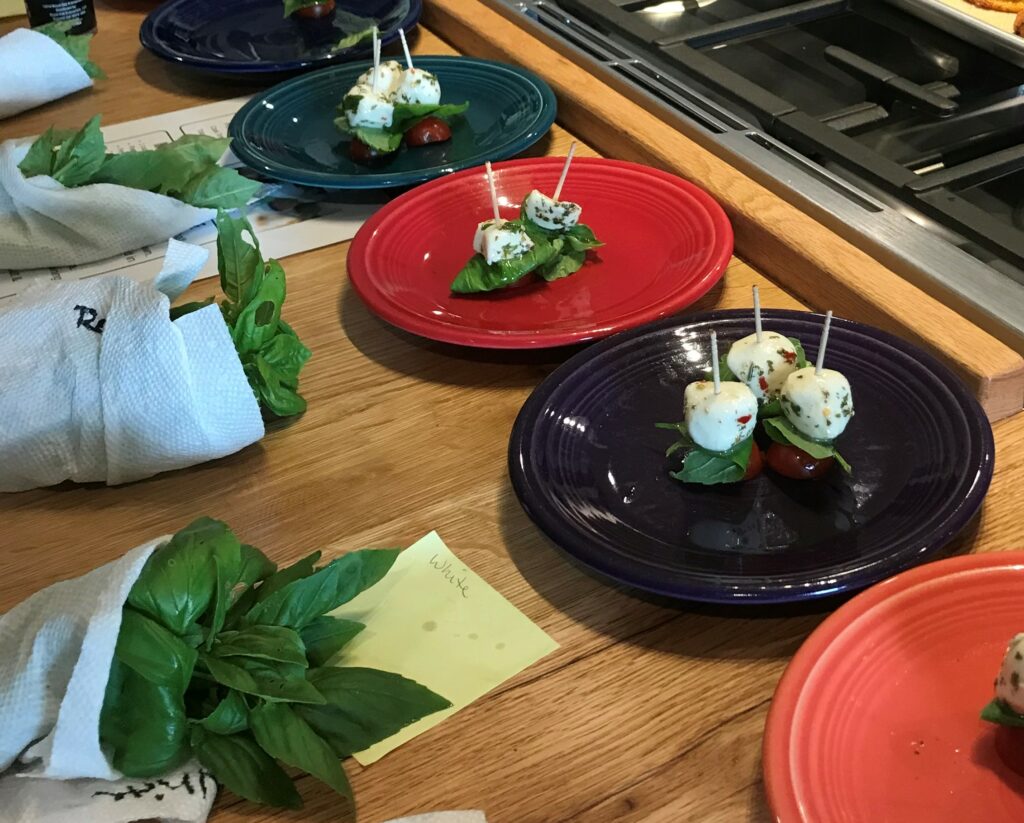
Taste-testing the different varieties of basil was part of the fun! Photo by Lisa Padgett, EMGV of Chatham County.
Participating county agents from across the state are now analyzing the data and plan to repeat the trial in 2022, implementing lessons learned from the pilot project in 2021. Involving MGVs in applied research and sharing the results with gardeners in local communities supports the NC State Extension Master Gardener program mission to connect people to horticulture through science-based education and outreach.
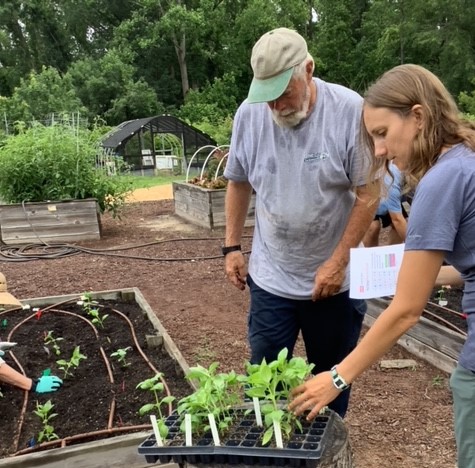
Jim Kwasnik, EMGV of Onslow County and Emilee Morrison, N.C. Cooperative Extension consumer horticulture agent plant the trial bed in the Discovery Gardens at the Onslow County Extension office. Photo credit: Emoni Burgess
For more information on basil downy mildew check out this fact sheet. We extend a special thanks to Johnny’s Selected Seed for donating seed of the BDM resistant varieties for this trial.
Learn more about how you can be part of the NC State Extension Master Gardener program!
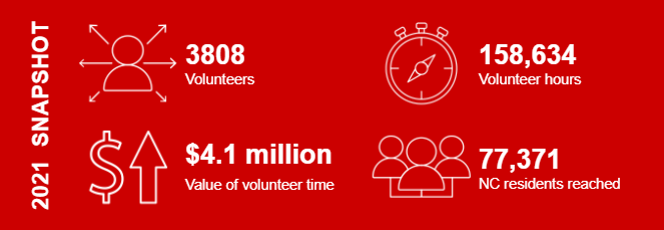
Read the 2021 Annual Report to explore more examples of how volunteers with the Extension Master Gardener℠ program share their knowledge to help North Carolinians learn and grow.


